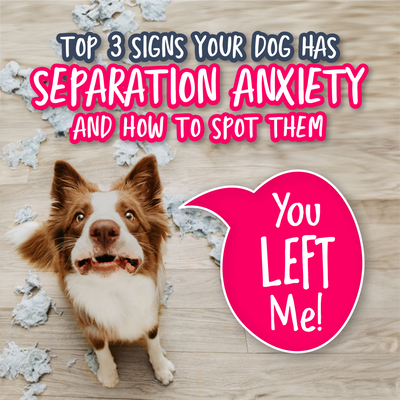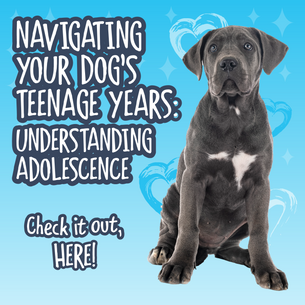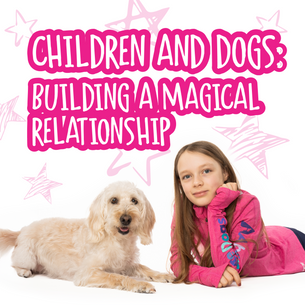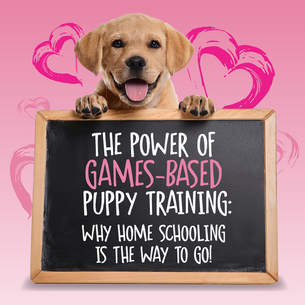How do I know if my dog has separation anxiety?
It’s a common question, and one you might find yourself asking as a dog owner.
Perhaps you’ve come home to find your skirting boards or your sofa cushions chewed, or you’ve had complaints from neighbours about the constant barking and howling while you’ve been gone. Or maybe there are more subtle signs your dog might not be comfortable while you’re out. Are they indications of separation anxiety? Are you concerned your dog might not be as settled as you thought?
How can you know? And more importantly, if your dog is struggling when you’re gone, what can you do about it? How can you take the necessary steps to alleviate your dog’s stress?
Join us as we uncover three common signs of separation anxiety in dogs, show you how to spot them - and, just as importantly, give you some practical tips and strategies to help.
Separation Anxiety Sign 1. Excessive Barking or Howling
What to Look For:
One of the most noticeable signs of separation anxiety is excessive barking or howling when your dog is left alone. This isn’t just a casual bark here and there; it’s a persistent and often frantic vocalisation that occurs when you’re away.
Why It Happens:
Dogs are social animals and rely heavily on their human companions for comfort. Not every dog naturally wants to spend time alone, or has the skills to be able to do so. If your dog feels insecure, or is lacking the skills to relax and be calm in your absence, they may vocalise their distress, or frustration, as a way to cope.
How to Spot It:
- Record your dog when you leave the house to see if they bark or howl excessively, and to catch other signs of anxiety that might be less apparent. Typically, dogs who display separation anxiety will do so within the first 10 minutes of being left alone. This is key, because it helps you differentiate separation anxiety from behaviours caused by boredom or lack of enrichment that might happen if you’re gone for longer periods of time. Or you may find your dog goes through cycles of barking/howling and resting and shows other signs of anxiety while you’re out, including pacing, panting and lip licking.
- Ask neighbours if they hear your dog barking or howling while you’re away.
Complaints from neighbours could be the reason you know your dog is struggling while you’re out - but if you’ve not already had grumbles from next door, it’s worth checking in and asking if they ever hear your dog while you’re gone.
Separation Anxiety Sign 2. Destructive Behaviour
What to Look For:
Destructive behaviour is another common sign of separation anxiety. This can include chewing furniture, scratching doors, tearing up household items, and other forms of destructive activity. It’s another easy one to spot - and a frustrating one to deal with! It’s also potentially dangerous if your dog swallows something harmful while you’re not there to notice.
Why It Happens:
Destruction often results from panic or frustration. Dogs with separation anxiety may attempt to escape from confinement or express their anxiety through destructive acts. It’s a coping strategy, and one that your dog may choose again and again if they find it helps them feel better in the moment. Again, it’s important to differentiate this from behaviour that indicates boredom - so those first 10 minutes are a good indication of whether your dog is genuinely struggling with being left alone.
How to Spot It:
- Check for signs of destruction around the house, especially near doors and windows.
- Look for patterns to see if the behaviour only occurs when you’re not home.
Separation Anxiety Sign 3. Following You Around the House
What to Look For:
Believe it or not, one of the most common signs that your dog is anxious or unsettled when you leave the house is often staring you in the face while you’re at home!
Does your dog follow you around like a shadow? Maybe they sit and whine outside the bathroom door while you’re taking a shower, or leap up and greet you like a long lost friend when you return from a trip to the kitchen to make a coffee. Their enthusiastic greetings are heartwarming, but perhaps they feel a bit over the top!
What if you enforce separation while you’re at home? Maybe you want to leave your dog safely in the house while you do a spot of gardening, or wash the car. Your dog knows exactly where you are. They have the reassurance of your presence - but they can’t get to you! Do they bark, howl and generally get loud? Maybe that same destructive behaviour happens while you’re just the other side of the door. What’s that all about?
Why It Happens:
This is a pretty good indication that your dog doesn’t have the necessary skills to relax and embrace calmness in your presence - which is crucial if they are going to be able to relax in your absence. It’s also a good clue that your dog’s understanding of the world revolves around having constant access to you. Anything else is simply not compatible with this blueprint. There’s probably some tolerance of frustration missing too. You might notice your dog gets easily frustrated in other situations too.
How to Spot It:
- Observe your dog when you move around the house. Do they follow you? Are they alert to your movements, always following you with their eyes?
- Can your dog relax in a crate, pen or separate room of the house, or do they struggle any time they’re unable to get to you? How does their behaviour and response to being separated change if that separation is enforced rather than being their choice?
How to Help Your Dog - Separation Anxiety Solutions
If you recognise these, or any other signs of separation anxiety in your dog, there are some really important dos and don'ts that are going to allow you to take action to help alleviate their anxiety. Read more in our blog post Separation Anxiety - The Dos and Don’ts.
Here are some other simple steps you can take:
1. Games-Based Training: Any behaviour struggle you encounter with your dog - from barking and pulling on lead to reactivity and separation anxiety, is an indication that your dog is lacking certain key skills, so training is a vital part of the picture. Join us in Games Club for an endless variety of games you can play with your dog to boost and grow all these vital concepts, and target any training struggle you might encounter - or check out our struggle-focused training courses.
2. Teach Your Dog the Value of Calmness: A lack of calmness is the root of so many behaviour struggles. Dogs who don’t understand how to tune out, switch off and chill out, and who are anxious and vigilant about things happening around them will find it impossible to cope with being left alone. Dive into the free Absolute Dogs Calm eBook for top tips and strategies to help your dog embrace this king of all concepts.
3. Calming Supplements: Alongside targeted calmness training, supporting your dog with a natural superfood supplement such as A-OK9’s Calm-K9 could be the missing piece in the puzzle that will allow you to make headway in tackling your dog’s anxiety and seeing the true results of your training input.
4. Never use punishment: If your dog is soiling the house or destroying things in your absence, it’s important to recognise this as a symptom of distress and lack of skills. Don’t view this through a human lens and see it as an attempt to get back at you for leaving. That’s simply not how dogs operate. Punishment will damage your relationship with your dog and is almost guaranteed to worsen your dog’s anxiety, making it more likely that they will continue to struggle when left alone.
5. Avoid leaving your dog home alone whenever possible: Consider friends, pet sitters or family members who might be able to step in if you really do need to leave. It’s important to recognise that if your dog is struggling in your absence, repeated exposure to the same level of distress will only intensify that reaction. Rather than “getting used to it” with time, most dogs with separation anxiety get worse without training input.
6. Get help: You don’t have to tackle the tricky terrain of your dog’s training journey alone, especially if you’re unsure where to start. Take the worry and the guesswork out of deciding when to push forward in your training, and when to hold back by signing up for our FREE live training event.
Free Live Training - Sign Up Now
Working through separation struggles with your own dog, or keen to learn more?
Join us on Thursday 27th June for a free live training event dedicated to separation anxiety.
With years of experience and a passion for transformative, games-based dog training that achieves real life results, our pro trainers will bring you real LIVE dog training that gets to the heart of your dog’s separation struggles, addresses the “why” behind their behaviour and gives you practical strategies that will skyrocket your dog’s separation success.
Register below and we’ll send you more information nearer the time.




